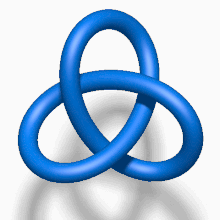纽结理论

纽结理论 (英语:Knot theory) 是拓扑学的一个分支,研究纽结的拓扑学特性。


历史
结绳纪事由来远古,但从数学上研究纽结,始于德国数学家卡尔·弗里德里希·高斯,高斯研究电磁场的性质,认为与纽结有关。1867年开尔文勋爵认为原子是以太漩涡的纽结,可用不同种类的纽结将原子分类,并用来解释为何原子的吸收光谱呈现不连续的现象。
苏格兰理论物理学家彼德·G·泰特用多年时间研究出纽结分类表,相信他正在创造一个元素表。1887年迈克耳孙-莫雷实验证明“以太”不存在,“以太漩涡论”成为过时理论。十九世纪末叶,产生拓扑学,纽结论再次成为热点研究课题。今日纽结论的应用包括弦理论、DNA复制和统计力学等领域。
Reidemeister移动

1927年,J.W. 亚历山大 和G.B. Briggs,以及 Kurt Reidemeister 独立地提出了如何判定两个结是相同的方法:如果由一个结可以透过几种基本的动作变成另一个结,它们便是相等的。这些运算称为Reidemeister移动。
高阶纽结图
一个维球,只可以在维空间扭成结,而且必定能在维空间解结。(E.C. Zeeman)
纽结连通和
两个结可以“相加”。考虑两个结的平面投影,假设投影不相交。在平面找出一个长方形,使得每个结都有一条线在长方形内,结的边靠近长方形的对边,而且长方形其他部分没有和结相交。将两线剪开,上面的部分和上面的部分连起,下面的和下面的连起。这运算称为连通和。
这个在结的运算,形成了一个交换的幺半群,且有素分解:如果一个结K只可以写作K+0=K或0+K=K,K便是素纽结。(0表示没有扭过的结。)
陈-西蒙斯理论和纽结多项式
|
主条目:陈-西蒙斯理论 |
三维的陈-西蒙斯理论生成很多重要的纽结多项式和纽结不变量:[1]
| 陈西规范群G | 纽结多项式或不变量 |
|---|---|
| SO(N) | 考夫曼多项式 |
| SU(N) | HOMFLY多项式 |
| SU(2)或SO(3) | 锺斯多项式(跟括号多项式有关) |
| U(1) | 环绕数 |
参看
参考文献
- ^ Witten, Edward. Quantum field theory and the Jones polynomial. Communications in Mathematical Physics. 1989-09, 121 (3): 351–399. ISSN 0010-3616. doi:10.1007/BF01217730 (英语).
| ||||||||||||||||||||||||||||||||||||||||||||
Text is available under the CC BY-SA 4.0 license; additional terms may apply.
Images, videos and audio are available under their respective licenses.




